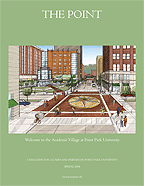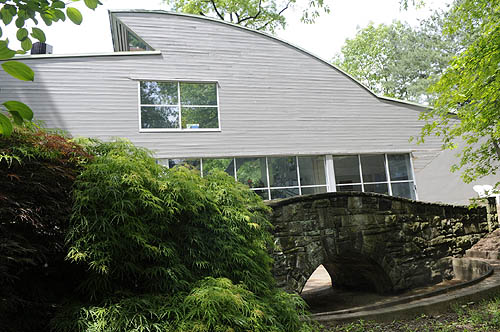
Category Archive: City Living
-
Market Square’s makeover shifts into high gear this week
Monday, June 30, 2008Market Square’s transition is in full swing.
Dunkin Donuts opens there at 6 a.m. today. Moe’s Southwest Grill will open Thursday. A dark, romantic bar is to follow later this summer.
In addition, a veteran restaurant, Buon Giorno, is dressing up for a higher profile. Renovations are ongoing to add a second-story deck that has passed the city’s historic review. And the former Mick McGuire’s will become a wine, cheese and dessert bar called Sante — with an accent on the “e” — later this summer beside the 1902 Landmark Tavern.
Of Sante, Mike Edwards, president and chief executive officer of the Pittsburgh Downtown Partnership, said, “It is supposed to be very romantic. So dark you have to be close” to see each other.
Dunkin Donuts brings another choice of coffee and baked goods within a stone’s throw of Nicholas Coffee, Crazy Mocha, Bruegger’s Bagel Bakery and Starbucks.
When questioned about a possible glut of caffeine choices, Robin Frederick, vice president of marketing and human resources for Dunkin Donuts, said Market Square was an attractive site for the company’s expansion.
“We’re going to do what we do best and hope they do too,” she said of the competitors.
Mr. Edwards said Market Square’s renovation plans have generated “a lot of public buy-in and set a direction for investors to make confident decisions.” He said the years of debate over the Fifth and Forbes make-over stagnated Market Square’s.
“Now we have direction,” he said, citing a $1 million “Paris-to-Pittsburgh” grant from the Colcom Foundation to match up to $25,000 the cost of any restaurant renovation that opens it to the outside. The Pittsburgh Downtown Partnership is administering the grants, which will enable “use of the city the way it should be used, not just as an office park.”
The Paris-to-Pittsburgh grants target Downtown merchants only, he said, adding that Moe’s Southwest Grill “is probably the best use of it.”
Moe’s co-owner Mike Geiger said the restaurant will open to the outside with three bays of windows, each 15 feet wide, and six retractable awnings. It will be the first Moe’s in the city, with four others in the region.
Buon Giorno and Mixstirs, a casual restaurant that offers a range of smoothies, are also going for the Parisian look, and Mr. Edwards said other restaurants have expressed interest.
True to its name, the square becomes a marketplace every Thursday through Oct. 23, with vendors selling fresh produce, baked goods, salsas and other items, from 10:30 a.m. to 2 p.m.
The Fifth and Market project, in which Pittsburgh History & Landmarks Foundation has invested, is also under way and will include several condominiums.
“There’s a maturing going on in Downtown Pittsburgh,” said Mr. Edwards, citing restaurants that have broadened and elevated diners’ tastes. “All the huge, great wonderful projects are important,” he said, but the smaller ones are the connective tissue that will keep making the city compelling.
Diana Nelson Jones can be reached at djones@post-gazette.com or 412-263-1626.First published on June 30, 2008 at 12:00 am -
Point Park University Alumnus Howard B. Slaughter Jr. – Catalyst for Community Growth and Development
 by Colleen C. Derda
by Colleen C. Derda
The Point Magazine, Spring 2008
Point Park UniversityHoward B. Slaughter Jr., D.Sc. (MBA ’01), is enjoying his latest riverfront views. From the offices of Landmarks Community Capital Corp. in Station Square, he can see down the Monongahela River toward Point State Park.
“This office has a great view of Pittsburgh architecture,” says Dr. Slaughter, a man who appreciates old buildings and knows what it takes to restore them. His extensive financing background focuses on economic development and housing developments in urban areas.
Slaughter heads the new Landmarks Community Capital Corp., a wholly owned subsidiary of the Pittsburgh History & Landmarks Foundation, which provides equity, debt and short-and intermediate-term financing for housing and economic development activities throughout Western

Pennsylvania, West Virginia and Ohio. The nonprofit corporation also aims to pursue public policy initiatives and public-private partnerships as well as utilize such tools as new market tax credits to bring additional capital into the region.
“We have the opportunity to be a catalyst for change,” he says. “Typically we are ‘first in and first out,’ often taking the greatest financial risk, to help move developments forward. We require collateral, but we are a non-traditional lender, with the flexibility to help make revitalization a reality.”
Landmarks Community Capital Corp. recently approved a $885,000 loan leveraging a $7-million revitalization condo development in East Liberty. Working through East Liberty Development Inc., the funding will help transform a former YMCA into condominiums and retail space. Landmarks Community Capital Corp. is also working to attract a supermarket to Pittsburgh’s Hill District, among other unique development projects.
“We have an experienced staff, reflecting ethnic diversity, which helps us to be as effective as possible and to effectuate positive change,” stresses the chief executive officer. “Not only urban neighborhoods, but rural communities can benefit from the corporation’s funding. We work within a 250-mile radius of Pittsburgh.”
Slaughter’s approach to community lending integrates historic preservation as a stimulus for economic development. He previously served as director of preservation services at the Pittsburgh History & Landmarks Foundation before being appointed director of Fannie Mae’s Pittsburgh Community Business Center, the largest source of home financing in the country. His background also includes a stint as a vice president of community development at Dollar Bank, where he led the bank to its first “Outstanding” Community Reinvestment Act rating.
Slaughter was recently appointed treasurer of the Urban League of Greater Pittsburgh and renominated by Gov. Ed Rendell (and unanimously confirmed by the Pennsylvania State Senate) to the Board of the Pennsylvania Housing Finance Agency board. He also serves on the board of the Pennsylvania Community Development Bank. His extensive educational background, which includes five degrees, includes a master of business administration from Point Park.

“I am pleased to have had the opportunity to take advantage of what Point Park offered.
I attended the master’s degree program all day every Saturday for an entire year. It was a commitment, but it enhanced my educational goals and fit my needs well,” says Slaughter, who also holds a master’s degree from Carnegie Mellon University’s H. John Heinz III School of Public Policy and Management and a doctorate in information systems and communication from Robert Morris University.
Slaughter can see a bit of Point Park University from his Station Square office. “I’ve been watching Point Park transform,” he says. “The changes are exciting and a real benefit to the urban core of this region.”
-
Landmarks Community Capital Corporation Invest in Loft-Style Town Homes in Bloomfield/Garfield
Landmarks Community Capital Corporation (LCCC) announced at a press conference/ground breaking on Wednesday, April 16th that it has made a $462,000 equity investment into the new loft-style townhouse development located at 5000 Penn Avenue in the Bloomfield/Garfield section of Pittsburgh by Friendship Development Associates, Inc. (FDA).
Howard Slaughter, Chief Executive Officer of LCCC says, “The development of this loft-style housing, or ‘lofters’ as I call them, fill a blighted vacant lot on a major corridor. It will also have attractability to workers at the new Children’s Hospital just two blocks away and continue to shore up the business corridor of Penn Avenue and provide quality housing for three new families. We are pleased to provide this equity investment to FDA and look forward to working with them on the construction of this development. “ FDA’s Real Estate Manager, Courtney Ehrlichman, says this development will be key in maintaining their efforts to keep the revitalization on the Penn Avenue corridor ongoing and strong.
In attendance at the ground breaking was Mayor Luke Ravenstahl who said “Urban loft-style townhouses are becoming more popular around the country, and Pittsburgh is always on the cusp of new and innovative ideas. This development is representative of the opportunity to increase marketability in Pittsburgh’s urban communities by developing a mix of affordable and market-rate housing, thereby making communities more sustainable by establishing better diversification of incomes, style of housing and ethnicity of communities. The Urban Redevelopment Authority’s funding of $161,297 in this development is a prime example of private/public partnership, which is the nexus of true neighborhood revitalization.”
The development is scheduled for completion within the next eight months.
-
Modern Venture: Home designed by famous architect on history group’s East End tour
Saturday, May 31, 2008Like the elegant orchids in her kitchen windows, Betty Abrams’ love of beauty bloomed in a nurturing environment. Her mother designed the family’s English Tudor home on Beacon Street in Squirrel Hill and loved fashion; her father’s furniture sales on the streets of Braddock attracted buyers to his business, Ohringer Home Furniture Co.
Mrs. Abrams still recalls what features she liked best about the homes of her childhood friends and has read architectural magazines all her life.
So, it’s not surprising that she interviewed five architects before choosing Robert Venturi, winner of the 1991 Pritzker Architecture Prize, to design her Woodland Road home, which will be featured on Tuesday’s tour sponsored by Pittsburgh History & Landmarks Foundation, the city’s largest preservation group.
Set on an acre of wooded land with a view of a 100-year-old stone bridge and three Japanese maples, the home, which features an entire wall of southern exposure windows, invites the outdoors inside.
Mrs. Abrams asked Venturi if he had ever visited the East Wing of the National Gallery in Washington, D.C., a sleek, light-filled space that is the work of I. M. Pei.
“That’s what I want,” she told him. “And that’s what I got,” she said during an interview last week. “I made Venturi listen to me.”
No walls separate the home’s kitchen, living room, bars and dining room, which are all visible as soon as you enter the first floor. The home’s most dramatic feature is a floor-to-ceiling window that is shaped like a ship’s wheel and cut into eight pieces.
Her late husband, Irving, was floored by the window’s design when he saw it on the blueprints.
“It’ll be OK. You’ll get used to it,” Mrs. Abrams told him.
A determined woman, Mrs. Abrams knew what she wanted — a 10-by-15-foot walk-in closet in the master bedroom, a lap pool just off the master bath, a heated two-car garage, maid’s quarters, and a living room and kitchen large enough to entertain.
The Abrams bought the land in January 1979.
“We broke ground in September of 1980 and moved in in April of 1982,” Mrs. Abrams recalled, adding that she began working as a financial adviser so she could afford to buy art for the couple’s new home.
The focal point of the living room is a Roy Lichtenstein print of a domestic scene; lowering the artwork by about a foot made a huge difference in how it looked and harmonized with the architecture, she added.
Noel Jeffrey finished the home’s interior design, selecting three shades of blue that are all visible as you stand in the living room. A light blue ceiling and darker shades of that color set off the balcony of an overhead loft that contains a library. Three clerestory windows light up the ceiling, intensifying the illusion of a blue sky overhead.
Three modern red chairs in the living room face a three-section sofa that once sat in the Pittsburgh Room of the Duquesne Club. After buying it at auction, she had the sofa reupholstered with understated multicolored fabric she found in Las Vegas.
The black and white marble dining room table has four chairs painted in a periwinkle automobile paint. Soothing celery green walls set off a neatly arranged, mirrored bar.
Long before granite counter tops became fashionable, Mrs. Abrams chose black and white granite for the kitchen and for two long bars where she serves appetizers and cocktails.
An accomplished cook who taught cooking and ran a catering business years ago, Mrs. Abrams insisted the kitchen be wider than Venturi had planned. She also rejected the idea of a grand staircase. When the Carnegie Museum of Art exhibited Venturi’s designs in 2002, the architect conceded that she had been right as he savored a bowl of her mushroom barley soup while seated in her dining room.
In her will, Mrs. Abrams has bequeathed the property to PHLF. Some day — when the house is at least 50 years old — it may be listed on the National Register of Historic Places due to its distinctive features and the significance of Venturi’s contributions to post-modern architecture.
In the meantime, its caretaker is enjoying it immensely. She particularly loves the rectangular skylight in the master bath.
“When I take a bath, I can look up and see the moon,” she said.
Marylynne Pitz may be reached at 412-263-1648 or mpitz@post-gazette.com.First published on May 31, 2008 at 12:00 am -
Printer manufacturer to plant trees in area parks
By Allison M. Heinrichs
TRIBUNE-REVIEW
Wednesday, May 7, 2008A company that relies on paper is planning to plant 250 trees in Pittsburgh’s parks.Boston-based Riso, which makes digital printers and photocopiers, announced Tuesday that it will begin the plantings this weekend in Riverview Park in the North Side.That planting will commemorate the grand-opening of the company’s North Shore branch, which it opened about a year ago, after nine years in the South Hills.
“Twice a year for the next four years we’re going to do spring and fall plantings in Pittsburgh’s parks,” said branch manager Rick Laird. “We really want to make an impact in Pittsburgh.”
The company plans to plant 100,000 trees in U.S. parks as part of a partnership with the Arbor Day Foundation.Office Technology Magazine this year recognized Riso as the “most green” office technology dealer because of its focus on environmental stewardship. The company’s copiers use soy-based ink and conserve energy.
All the trees to be planted in Pittsburgh are native to Western Pennsylvania and include cucumber magnolia, American beech, redbud, tulip poplar and serviceberry.
“We’ve lost many trees over the years,” said Phil Gruszka, director of management and maintenance at the Pittsburgh Parks Conservancy. “We’ve found that there are a number of places that currently don’t have trees that should, so we definitely appreciate this.”
Allison M. Heinrichs can be reached ataheinrichs@tribweb.com or 412-380-5607.
-
Rescue plan for Downtown’s Market Square is expanding
By Ron DaParma
TRIBUNE-REVIEW
Monday, April 28, 2008The Pittsburgh History & Landmarks Foundation is tackling another building rescue project in Market Square, with the aim to further a transformation already under way in the historic Downtown public square.The South Side preservationist organization announced today it will take on restoration of the Thompson Building, a three-story structure adjacent to a trio of vacant buildings where it is spending about $2.5 million to convert into a mixed use complex known as Market at Fifth.Acquisition of the building will enable the foundation to expand its complex into that structure.
Plans for 439 Market St., 441 Market St., and 130 Fifth Ave. include a ground-level restaurant or retail store, seven upper-floor apartments and a rooftop garden.
In addition, the foundation also announced it was given an “easement in perpetuity that will protect the architectural quality of the Buhl Building, another structure on Fifth Avenue near Market Square.As reported, eight new shops have moved in — or will in the coming months — further rejuvenating the 224-year-old square.
Businesses there have credited an increased police presence to fight crime, reduce panhandling and efforts to clean up the city’s streets.
More recently, new programs have been introduced, such as the Pittsburgh Downtown Partnership’s Paris to Pittsburgh program that is providing matching grants to help restaurants and other merchants renovate their buildings and expand their operations onto sidewalks — similar to venues popular with tourists in the French capital.
Ron DaParma can be reached atrdaparma@tribweb.com or 412-320-7907.
-
Preservation group takes control of Market Square block
By Diana Nelson Jones,Pittsburgh Post-GazetteMonday, April 28, 2008The Pittsburgh History & Landmarks Foundation has joined forces with N&P Properties to control the development of almost a block of buildings on Market Street, between Fifth Avenue and Market Square, Downtown.
Two five-story buildings in that block are now shells in the process of renovation into seven apartments, and a third will join the other two as retail space on the sidewalk level.
The foundation last week bought the Thompson Bakery building, which now houses the restaurant Ciao Baby, and N&P bought the Buhl Building at the entrance to Market Street at Fifth Avenue and gave the foundation an easement in perpetuity to protect the architectural integrity and terra-cotta facade.
-
Barden to honor $3 million pledge for Hill development
By Mark Belko and Rich Lord,Pittsburgh Post-GazetteMonday, April 28, 2008North Shore casino developer Don Barden will maintain his $3 million pledge to the Hill District after all.
After meeting today with Allegheny County Chief Executive Dan Onorato and Pittsburgh Mayor Luke Ravenstahl, Mr. Barden said the money would be spent over five years to “spur economic development” in the Hill above the Mellon Arena. He had originally pledged to commit the money within three years in the area near where a new hockey arena is being built.
Mr. Barden described his decision as a “happy medium.” He had petitioned the state gaming board to drop the commitment, saying it was contingent on getting development rights to the arena area. Those rights went to the Penguins.
Now Mr. Barden said he is planning to spend the money deeper into the Hill District.
Mr. Onorato and Mr. Ravenstahl praised Mr. Barden for continuing his commitment and said they would send a letter to the gaming board to support his bid to refinance the construction of the North Side casino.
Mr. Barden said the financial struggles of his casinos in Indiana, Colorado and Mississippi will have no bearing on the Pittsburgh project. He said they are entirely separate entities. Mr. Barden is seeking to refinance the casino project because costs have escalated.
He also dismissed concerns raised by Standard & Poor’s ratings service last week as technical in nature. He said Moody’s released a much more favorable number today.

